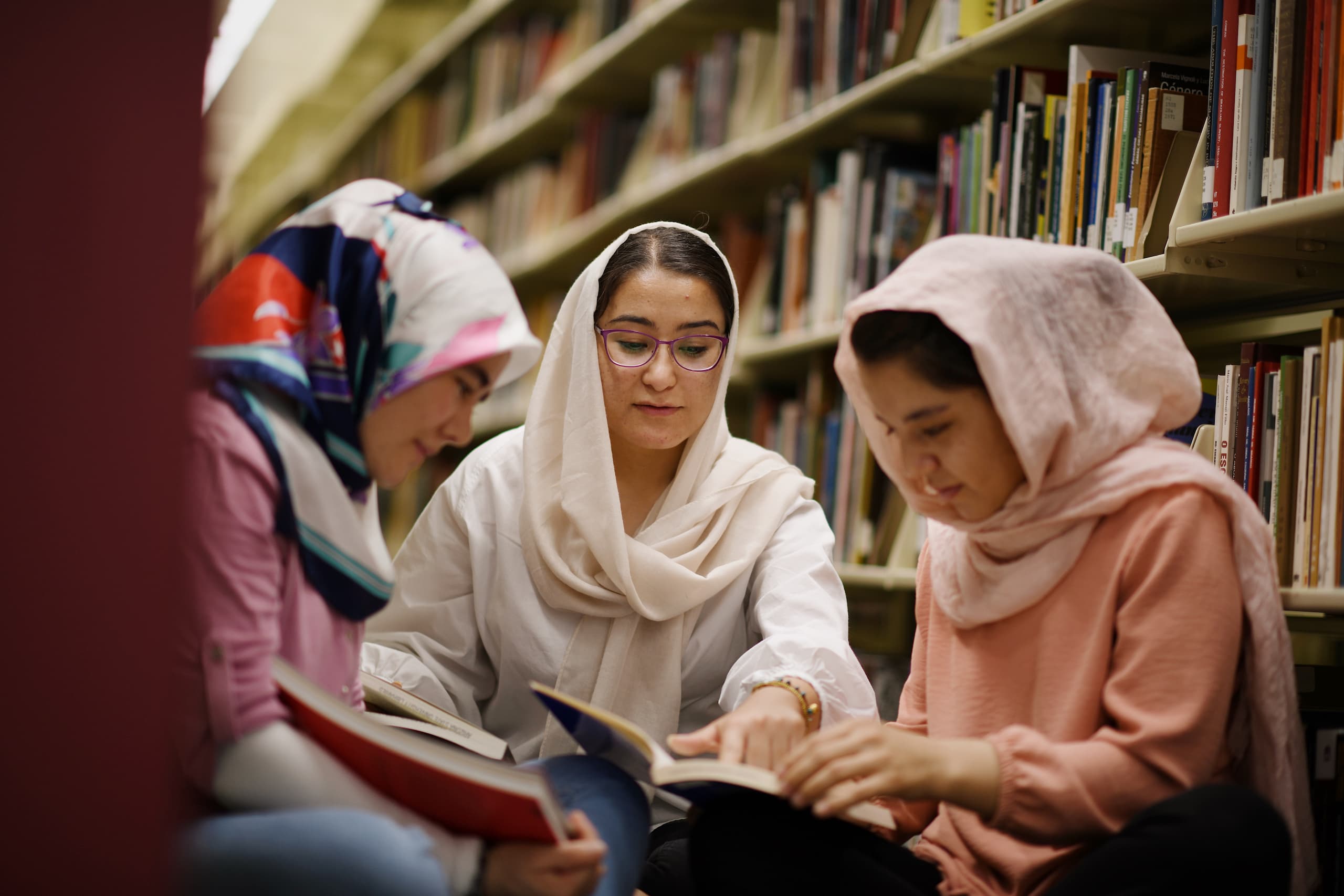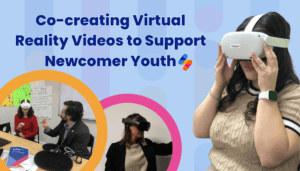This is the second part of a series on school integration for refugee youth and their families.
While most students in the U.S. start the school year thinking about their locker decor, who their favorite teacher might be, and whether they’ll get to sit next to their crush in math class, most newcomer youth arrive in the U.S. with a different set of concerns. After months, if not years, spent in stressful and often dire situations, they finally have a place to call home again. This time, it looks little like the home they once knew, and they’re not surrounded by a larger network of friends and family. Their guardians are likely just as overwhelmed, acclimating to a new culture and language, along with new social roles, currency, roads, and everything else that community integration requires.
Successful integration depends on the efforts and resiliency of newcomers themselves, but much of it can also be shaped by the active engagement of community members and the culture of welcome we all create. Schools are especially helpful places to begin this process, particularly because a large percentage of forcibly displaced people are under the age of 18. This blog post will explore strategies that districts, schools, and educators can take to ensure newcomer youth and their families feel empowered in their integration processes.
Integration Strategies for Administrators
Of the long list of duties we imagine school administrators handling, phrases like “language justice” or “refugee family liaisons” aren’t very common. And yet, administrators across the country have implemented policies that improve school environments and support vulnerable populations like refugees and other newcomers. For example, the Elementary and Secondary Education Act (ESEA) characterizes language justice as a “legal requirement,” which means that communication with the school community should take place “in an understandable and uniform format and, to the extent practicable, in a language that the parent can understand.” Whether we’re talking about the translation of school notices or larger diversification efforts, administrators have the power to set these equitable principles and practices in place.
Here are several innovative examples of how schools around the U.S. have helped newcomers feel welcome from the moment they walked through the doors:
- Hire refugee family liaisons who serve as cultural brokers for various newcomer communities. This has been successfully done in several districts across the country, such as the Bilingual Liaisons directory in Lincoln, Nebraska, and Child Accounting Secretaries like Ms. Norieah Ahmed in Dearborn, Michigan. Not only are these liaisons able to speak to families directly in their home language on behalf of the school, but they can also do so in a culturally sensitive way to ensure families have positive associations with their school, leading to further positive academic and social outcomes for their children.
- Partner with programs and institutions to diversify the educator hiring pool. The majority of educators in our country are still White women. “Grow Your Own” teacher pipeline programs, like North Carolina’s Teacher Cadet Program, create opportunities for youth from under-represented minority groups to work toward becoming certified educators themselves. Hiring teachers and other staff from the cultural and linguistic backgrounds of your students can have transformative effects. It is extremely beneficial for students to have role models from their own backgrounds who accompany them through their acculturation and integration processes. Administrators can partner directly with community colleges, universities, and their Department of Education to explore what these kinds of opportunities can look like in their own school contexts.
- Empower school staff to provide culturally sensitive services. Partnerships with local refugee service providers and ethnic community-based organizations (ECBOs) for professional development (PD) programming can help. Bringing in local experts who work daily with newcomer populations can provide perspective on what considerations different school staff can take in welcoming newcomers. For example, front office staff may not be aware that certain refugee and newcomer populations place a great deal of cultural significance on greetings, and that leading with “How can I help you?” may actually be considered unwelcoming. Additional professional development and trainings (like the Switchboard e-learning module “Introduction to Working with Interpreters”) can serve as helpful tools for working with interpreters so that all staff know how to ensure information is exchanged appropriately across cultures.
Self-Assessment Tool
As an administrator, ask yourself…
- Do you have a department or center within your school system specifically dedicated to providing multilingual services for all language backgrounds in your community? If not, do you work with any external vendors, refugee resettlement agencies, or ECBOs that can provide multilingual services when a family needs support in common refugee languages like Arabic, Pashto, or Swahili?
- What are you doing as a leader in your school or district to promote multiculturalism?
- What refugee service providers, ECBOs, faith-based organizations, and other institutions can you partner with in your community to better meet the needs of newcomer students and their families?

Integration Strategies for Counselors
Counselors are often the people designated to facilitate the initial welcome of a newcomer on their first day of school, walking through the halls together and pointing out what will be essential for the student’s first weeks. Newcomers from different cultural and geographical backgrounds may be accustomed to entirely different education systems or may have arrived without any prior formal education. They may lack context for the many roles school staff play in the U.S., the school’s schedule, and the variety of subjects and electives that students may take as part of their education. When providing school orientation, counselors must meet newcomer families where they are to ensure that the orientation is comprehensively addressing concerns and effectively equipping students with the tools they need to integrate into the school community.
For supportive integration, one of the most essential factors for a newcomer learner is that they feel a sense of belonging in their new community. Due to the social-emotional nature of this need, counselors are best situated to walk alongside newcomer students as they make friendships, build routines, and discover new learning strategies. Here are several ways counselors can support integration:
- Create a peer mentoring program. This can involve asking another student to be a “buddy,” a fellow student who has a similar enough schedule to accompany the newcomer and serve as a guide throughout the school day. While not essential for every newcomer student, peer mentoring by a student from the same linguistic and cultural background can be especially valuable, as long as the “buddy” does not feel encumbered or burdened by the added responsibility. Counselors should be intentional when selecting peer mentors, particularly with respect to observing gender norms.
- Encourage informal groupings. Peer mentoring can also be less overt through opportunities like lunch groups and community circles that cover various social-emotional topics. For those newcomer learners who may not feel comfortable being singled out and targeted for support, group work can be a less intimidating opportunity to make friends and share in a more communal setting. Additionally, facilitating groups for specific populations can be highly effective. For example, if your school is receiving many arrivals from Afghanistan, you might consider running separate groups for Afghan girls and boys to cover topics such as conflict resolution or emotional self-regulation.
- Facilitate access to therapeutic interventions. The stigma around discussing mental health in many cultures can make it challenging for counselors to encourage therapeutic intervention. For support in these conversations, counselors should work closely with school social workers, who play a key role in connecting students and their families to resources in the community. This may include referrals to therapists, help accessing health care, or even vouchers for supplementary food and clothing where appropriate. Newly arrived families may not know about these resources, and social workers can be a huge asset when it comes to resource mapping.
- Practice cultural sensitivity. Some newcomers may not even have ways to describe or understand emotional states or mental health in their home language and cultural context. To address these barriers, counselors can be strategic by asking families about their own practices when they are feeling sad or stressed. Other cultures often have their own deeply ingrained healing practices that may seem unconventional in the U.S. context but can be useful starting points for learning, relationship building, and mental wellness.
Self-Assessment Tool
As a counselor, ask yourself…
- How can you play a role in ensuring refugee and other newcomer students feel a sense of belonging at your school and with their peers?
- What sorts of skill-building groups could these students benefit from?
- How can you encourage newcomer youth and their families to get the help they may need while honoring their strengths?
- If you suspect a student may have serious mental health needs, what resources are available within your school and community? How can you ensure services are culturally and linguistically appropriate? What alternative services can be provided apart from therapy that may be more comfortable for newcomers while still addressing their mental health and wellness?

Integration Strategies for Educators
Students spend most of their waking hours in the classroom, and teaching staff serve as the stewards of their education through their instruction and modeling. The role of a teacher is to create a healing classroom by giving students a sense of control, self-worth, and belonging, while creating opportunities for positive relationship building and intellectual stimulation. Here are some strategies educators can implement to help newcomer students feel safe and comfortable enough to learn:
- Build predictability and consistency into the student’s day. Youth who experienced forced migration have undergone a great deal of change and have lost routines, competencies, and mastery in how they operated in their home culture. Educators can intentionally design their classrooms to equip newcomer students with tools that allow them to operate in their new environment with returned mastery, which they can use to their advantage toward integration. For example, teachers can post visual reminders of the schedule, pairing pictures with words to reinforce and improve understanding. Because the school setting does not always allow for consistency, educators should work to anticipate when changes in the flow of the day may be particularly disruptive or triggering to newcomer students, such as for planned fire drills or outside visitors, and clearly and consistently remind students using simple, direct, and understandable methods of communication.
- Encourage breaks and steady pacing. In your classroom, refugee and other newcomer students may be experiencing high levels of stimulation due to their cultural adjustment and resettlement stressors. This level of activation can be overwhelming for youth, and educators should be cognizant of students’ emotional needs. Gently and privately letting a student know that they can step away from a task when it becomes overwhelming and return to it later can relieve this stress, while empowering the student to make decisions for themself around their energy level. Educators can make sure students know that making mistakes, taking breaks, and acknowledging when they feel overwhelmed are not only okay but are also necessary parts of the learning process.
- Create space for the student to self-advocate and self-express. Educators should lean into strengths-based teaching styles that celebrate a newcomer student and their skills. Instead of focusing on their struggles to learn English, affirm their multilingualism. Instead of requiring that assignments be completed in writing, create alternative methods of participation through art or body movement. Instead of being frustrated by a student who doesn’t actively participate, validate the receptive learning skills they demonstrate through their attentive listening. Youth may be reserved at first, especially given how much of an adjustment this new learning context can be, but the class culture that you create will help newcomer students feel empowered and in control as they begin to share more of themselves, engage actively in their learning, and build deep relationships based on trust.
Self-Assessment Tool
As an educator, ask yourself…
- What can I do to build routine, consistency, and predictability into my class culture so that my newcomer learners can expand their mastery of their school environment?
- What are ways that I can get to know my student even if I do not share the same language or cultural background?
- How can I apply strengths-based teaching strategies in my classroom? Where do my newcomer students excel? How can I create opportunities for them to identify with their gifts and use them actively to help them build new skills?
Key Takeaways for Stakeholders

As Madina said in the preceding blog post, “Reflections from an Afghan-American School Counselor,” it truly takes a village to raise a child, and all members of school communities have a part to play in this village. No single person in any village should be responsible for every aspect of youth development. The success of a school depends not on each individual doing everything but on everyone working collaboratively in their respective roles. Newcomer students are best served by fully engaged community networks that include not only school staff but also resettlement agencies, ECBOs, the Department of Education, and other local immigrant service stakeholders. We hope that the strategies outlined in this piece may be helpful to you and others as we build the capacity of schools in our country to better welcome newcomers and support their integration.










